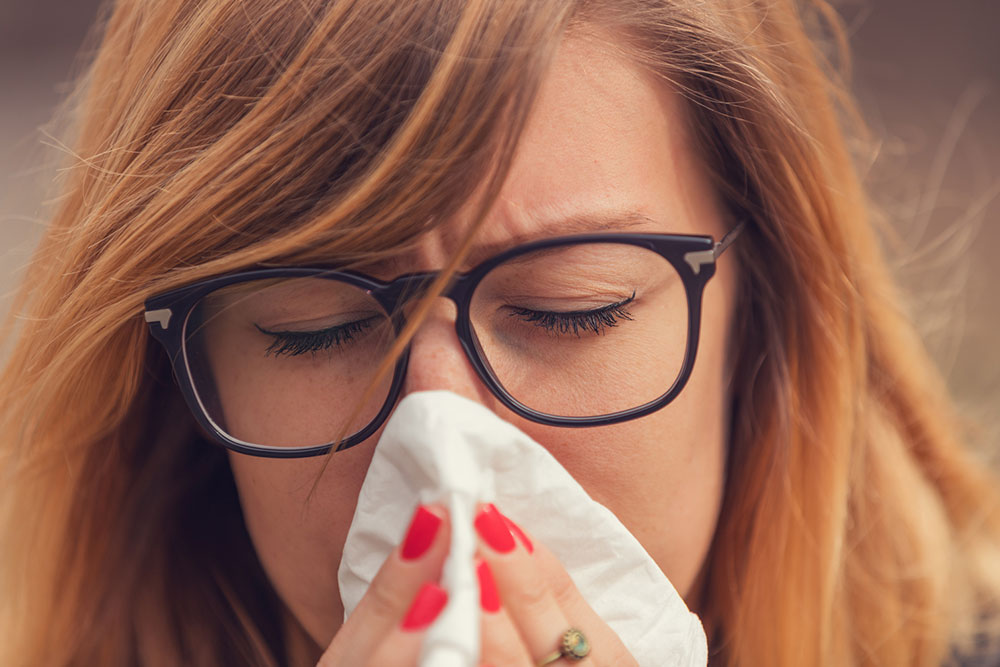Seasonal Allergy Triggers, Symptoms and Medications
According to the American Academy of Allergy, Asthma & Immunology, about eight percent of Americans have an allergy that occurs in a particular season. Seasonal allergies occur when your immune system overreacts to an outdoor allergen (something that triggers an allergic response), such as pollen. The pollens that spread seasonal allergies are from wind-pollinated plants, such as trees, grasses, and weeds.

Seasonal allergy triggers
The most common seasonal allergy trigger is ragweed, a wild plant that grows especially on the East Coast and in the Midwest. Ragweed blossoms and discharges pollen from August to November. Some other plants that trigger seasonal allergies are Burning Bush, Cocklebur, Lamb’s-quarters, Pigweed, Sagebrush and Mugwort, Tumbleweed, and Russian Thistle.
Climate factors can influence how badly your seasonal allergies are triggered. Tree, grass, and ragweed pollens grow during warm days and cool nights. Molds develop swiftly in heat and high humidity. Pollen levels tend to rise in the morning. Even though the rain washes the pollen away, pollen counts can rise after a rainfall. Airborne allergens are grounded on a day with no wind. The pollen counts rush when it is a windy and warm day.
Symptoms of seasonal allergies
Symptoms of seasonal allergies vary from very mild to severe. Some of the most common symptoms are sneezing, runny or stuffy nose, postnasal drainage, watery and itchy eyes, itchy sinuses, throat, or ear canals and ear congestion. The spring allergy symptoms include a runny nose, watery eyes, sneezing, coughing, itchy eyes and nose and dark circles under the eyes. The lesser common symptoms include a headache, shortness of breath, wheezing, and coughing. Some people may have asthma. Your seasonal allergens may trigger an asthma attack if you have seasonal allergies and asthma.
Seasonal allergy medications
Some of the seasonal allergy medications are as follows:
Antihistamines
Antihistamines are the best seasonal allergy medicines that reduce or block symptom-causing histamines. They are available in tablets and liquid form. Several oral antihistamines are obtainable as an over-the-counter medicine and in generic form. Make sure to read the label closely and follow dosing instructions when choosing an OTC antihistamine. Even though this is the best seasonal allergy medicine, some antihistamines may cause drowsiness. It is better not to drive or operate heavy machinery after taking those. Other antihistamines that do not have side effects are also available, but some non-sedating antihistamines are only available by prescription.
Nasal corticosteroids
A nasal corticosteroid is another best seasonal allergy medicine that is sprayed into the nose once or twice a day to treat inflammation. The side effects include stinging in the nose.
Decongestants
These drugs are available both by prescription and over-the-counter and come in oral as well as nasal spray forms. These are sometimes recommended in combination with antihistamines as antihistamines used alone do not have an effect on nasal congestion. Your nasal congestion could get worse if you use decongestant nose sprays and drops more than a few days may give you a rebound effect. These are beneficial for short-term use and relieve nasal congestion.
Immunotherapy
Another best seasonal allergy medicine therapy is allergen immunotherapy or allergy shot, as unlike others, you will learn to tolerate it rather than reacting with sneezing, a stuffy nose or itchy, watery eyes. In this therapy, your body responds to injected amounts of a particular allergen, given in gradually increasing doses, by developing immunity or tolerance to that allergen. A common course of treatment begins with a weekly injection for two to three months until the maximum dose is reached. The treatment can be continued monthly for three to five years after that. Another method of allergen immunotherapy therapy includes administering the allergens in a tablet form under the tongue and is designed for daily use, before and during the pollen season. However, they are not meant for instant relief. This therapy should start at least three to four months before the allergy season begins. The first doses are to be taken in the presence of a health care provider although they are intended for at-home use.
The symptoms of seasonal allergies can be annoying and disturbing. Talk to your healthcare provider if you suspect seasonal allergies. They can help you diagnose the cause of your allergy and recommend the best seasonal allergy medicine for you. The foremost thing they encourage you to do is follow a seasonal allergy chart and take steps to avoid the allergy triggers.











